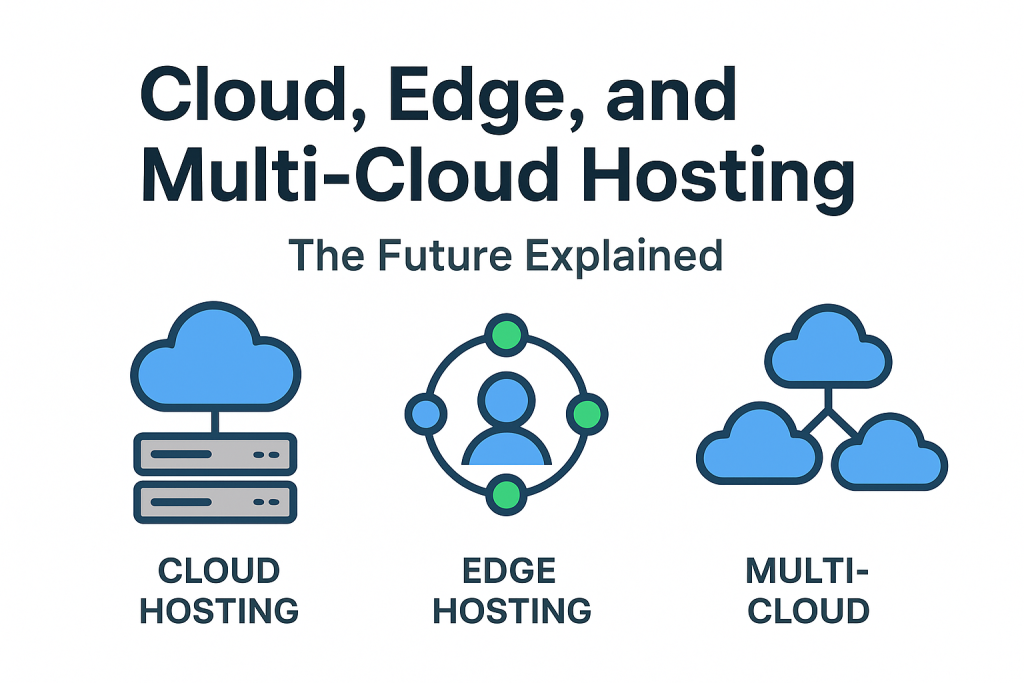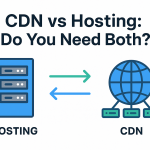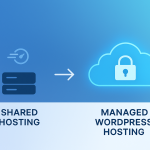In the past decade, the internet has become less like a collection of individual websites and more like a vast, interconnected digital city. And if your website or application is a building in that city, you need a solid foundation—a hosting strategy that guarantees speed, reliability, and room to grow.
The problem is, the jargon surrounding modern web infrastructure—Cloud, Edge, and Multi-Cloud—can sound like a foreign language, making it tough to know where to spend your hard-earned money.
We’re here to cut through the complexity. Think of us as your friendly guide, translating complex hosting concepts into clear, actionable insights so you can stop worrying about downtime and start focusing on your business.
1. The Foundation: Cloud Hosting—Your Flexible Digital Backbone
Forget the old days of web hosting. Traditional hosting meant your site lived on one single, physical machine. If that machine failed, your site went down. If you had a sudden traffic surge, your site crawled to a halt.
Cloud Hosting threw out that limitation.
Instead of one machine, your data and files are spread across a network of interconnected virtual servers (the “cloud”). This simple shift is a game-changer because it gives you three massive advantages:
A. True Scalability, Not Just “Growth”
Imagine a water tap. With traditional hosting, you pre-paid for a certain pipe size. If your traffic exploded (a sudden mention on a major news site, for instance), the pipe burst.
With Cloud Hosting, you can instantly turn the tap—adding or subtracting resources like CPU power, RAM, and storage on demand. If your traffic spikes, the cloud automatically allocates more power. When the rush is over, it scales back down. You only pay for what you actually use.
B. Bulletproof Reliability and Uptime
Since your site isn’t on one physical server, if one server fails, another one on the network instantly takes over. This means near-zero downtime. For businesses, this isn’t just a technical perk; it’s a guarantee that your storefront is always open.
C. Cost Efficiency That Makes Sense
Because of the pay-as-you-go model, the cloud is incredibly cost-effective. Small projects can start affordably, and growing businesses only see costs increase proportionally to their success.
Cloud Hosting is the perfect starting point for almost any modern business, dynamic blog, startup, or content-heavy site that values flexibility and cost control.
2. Getting Closer to the User: Edge Hosting—The Need for Speed
Think about ordering a pizza. You want it delivered fast, right? You’d prefer the pizza shop that’s two blocks away over the one that’s 20 miles away.
Edge Hosting applies that logic to your website.
Standard Cloud hosting still uses a central data center, which might be hundreds or thousands of miles away from some of your users. The “Edge” moves the delivery of your website’s data and computational power closer to the people actually using it—literally to the “edge” of the network.
Why does this proximity matter? Latency.
Latency is the tiny, measurable delay data experiences as it travels. Reducing latency is the single most effective way to create a better digital experience. By using Edge servers (often called Content Delivery Networks, or CDNs), your site’s content is cached and delivered from a geographic location closer to the user.
Who is Edge Hosting absolutely essential for?
- E-commerce Sites: Every millisecond of delay during a checkout process loses you money. Edge hosting ensures lightning-fast product pages and seamless transactions, which boosts conversions and dramatically lowers cart abandonment.
- Live Streaming/Video Platforms: Reduced buffering and delay is the only way to keep viewers engaged.
- IoT and Real-Time Applications: Devices (like smart home sensors or industrial monitors) need to send and process data instantly. Edge computing handles this at the source, ensuring real-time responsiveness.
If your audience is global, if speed is crucial to your user experience, or if you run real-time applications, Edge Hosting isn’t a luxury—it’s a performance mandate.
3. The Ultimate Safety Net: Multi-Cloud Hosting—The Power of Choice
Imagine you have all your business’s inventory stored in one warehouse. If that warehouse catches fire, your business is wiped out.
Multi-Cloud Hosting is the strategy of intentionally using services and infrastructure from two or more different cloud providers (like Amazon Web Services (AWS), Google Cloud Platform, Microsoft Azure, etc.) simultaneously.
This isn’t just about having resources on different servers; it’s about having different providers.
Why would you need multiple clouds?
A. True Resilience and Disaster Avoidance
If one provider suffers a major regional outage (and they do, occasionally), your workloads automatically shift to the other provider. This is the ultimate form of redundancy. Your online presence remains unshaken, no matter what happens to a single company’s network.
B. Avoiding Vendor Lock-in
This is a business-level decision. If your entire application is built using the proprietary tools of one provider, it becomes incredibly difficult and expensive to ever leave them. By spreading your resources across multiple vendors, you maintain flexibility and negotiating power, ensuring you can always migrate to a better, cheaper, or newer service.
C. Optimization and Best-of-Breed Services
Each major cloud provider has a specialty. AWS might have the best database service, while Google might excel at machine learning or container management. Multi-Cloud allows you to pick the best tool for every specific job, maximizing both performance and cost efficiency.
Multi-Cloud is ideal for global enterprises, financial institutions, or any organization where regulatory compliance, maximal uptime, and the ability to rapidly innovate are non-negotiable.
Tying It All Together: Your Strategic Advantage
Digital success today is about speed, sustainability, and scale. Cloud, Edge, and Multi-Cloud aren’t just technical buzzwords; they represent the ability to build a presence that can instantly adapt to a sudden 10x surge in traffic, deliver content to a user in Berlin as fast as one in Boston, and operate without ever fearing a complete network failure.
So, How Do You Choose?
- Start with Cloud Hosting: If you are a startup, a growing blog, or a small business needing flexibility and affordability, this is your bedrock.
- Add Edge Hosting: Integrate a CDN (the practical implementation of the Edge) the moment you start targeting a diverse, global audience, or when faster load times mean higher revenue (e.g., e-commerce).
- Adopt Multi-Cloud: This is the enterprise-grade step. If you require regulatory compliance across multiple regions, maximum financial resilience, or need to use specialized services from different vendors, Multi-Cloud is your path.
The future of the web is intelligent—systems powered by AI that dynamically shift your data between the Cloud and the Edge to ensure the perfect balance of cost and performance. Your mission right now is to build the foundation that is ready for that future.
The world of hosting can be confusing, but by understanding these three pillars, you are no longer making a guess; you are making a strategic business decision.
Where is your website today, and what goals are you trying to achieve in the next year? Understanding that will tell you exactly which one of these hosting strategies is right for you.



